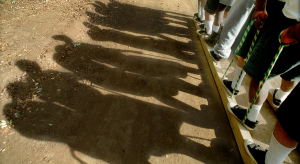
As arrests and incarcerations decline, county will put greater emphasis on prevention, intervention
East County News Service
September 15, 2015 (San Diego’s East County)--A major decrease in juvenile arrests and detentions has caused significant savings for the county, and now government officials are looking to transfer money into services that help keep young people out of serious trouble. In 2009, 5,000 juveniles were under supervision, but now there are approximately 2,100. Detention rates have had a similar decline, down from 842 to 438, said Ron Lane, deputy chief administrative officer.
On Tuesday, the Board of Supervisors voted 5-0 to transfer this savings to training for law enforcement officers dealing with young offenders, increased mental health services, and a program that helps stop juvenile family violence.
“We’re moving money from the back end of the system in juvenile hall, which is the least effective end of the system,” Lane said. The hope is that the shift in spending will result in even fewer young people in jail, he said.
“It’s not just about money, it’s about what’s best for kids,” he said.
The exact amount that will be reallocated is unclear, but a combination of grant and county funds will bolster existing juvenile services.
A total of $500,000 will go into diversion programs, Lane said. These are services where youths who are caught skipping school, vandalizing property or committing another low-level offense sign a contract where they agree to complete certain steps in exchange for not being charged with a crime. Their families are involved, and often the contract requires juveniles to undergo counseling, anger management, and drug and alcohol treatment.
Another $15,000 will go to train law enforcement on the various diversion programs available. This will help make law enforcement officers aware that they don’t always have to take young offenders to juvenile hall but rather can start diversion programs.
There will also be a $1.2 million contract with South Bay Community Services to expand its Alternatives to Detention program countywide. Just over $1 million will be funded by a Justice Department grant, while the county will pay the remaining $200,000.
Kathy Lembo, SBSC’s chief executive officer, said this service helps with youths who have committed an offense, but are better served outside of juvenile hall. Some might stay with their families to receive intensive intervention, others, particularly juveniles in a family violence situation, might be moved to a “cool bed” in temporary foster care.
Alternative to Detention served 295 young clients in south and central San Diego County since it launched three years ago. Now, with funding from a grant and county, it will serve approximately 500 youths across the county per year, Lembo said.
Of the 295 cases, 220 were closed successfully, and 85 percent of youths had not committed an additional offense six months after their case closed, Lembo said.
Money will also provide additional mental healthcare services and clinicians. Over 70 percent of the offenders they survey have a mental health or substance abuse problem, and most have seen significant violence, including a crime with a weapon or a homicide.
“We want to make sure we have as many of the correct behavioral health services for our youth” as possible, Lane said.
Research shows that it is better for the young offender and for the county to avoid sending people to juvenile hall, said Sandy McBrayer, chief executive officer of Children’s Initiative, an organization that helps determine the most effective social programs.
“The studies say that if you enter the hall, even if you didn’t commit the crime, you’re five to eight times more likely to come back,” she said.
Incarceration interrupts education, strains families, destroys social networks and carries hefty legal and governmental costs. It’s usually not the best option, McBrayer said.
“We know that disruption is very significant to a person’s trajectory,” she said.
Officials say the decline in juvenile incarceration is driven by a drop in the number of juvenile arrests. What’s prompting the drop in arrests, however, hasn’t been completely identified, and theories vary.
A January report from the the San Diego Association of Governments said a survey of law enforcement said that the decrease in juvenile arrests dropped in part from a greater emphasis on adult offenders as well as intervention programs.
The decline spanned felonies, misdemeanors and status offenses like curfew violations, skipping school and running away, the report said.
The ongoing decrease in juvenile arrests and incarcerations caused the county to close the Juvenile Ranch Facility in Campo earlier this summer and to transfer residents to Camp Barrett in Alpine. The consolidation was expected to save $700,000 per year. The county had spent $800,000 upgrading the facility over the past five years.
The possible changes to juvenile services are the result of a push from Supervisors Greg Cox and Ron Roberts this spring.
“As County staff contemplates related adjustments to juvenile probation facilities, it is incumbent upon this board to set policy to direct cost savings back into the juvenile justice system,” they wrote in an April memo.
For more information, Reporting San Diego covered today’s Supervisor hearing. You can read their story at http://reportingsandiego.com/2015/09/15/youth-diversion-pilot-expanded-by-county-to-all-county/ which also has a link to prior coverage of this successful program.











Recent comments